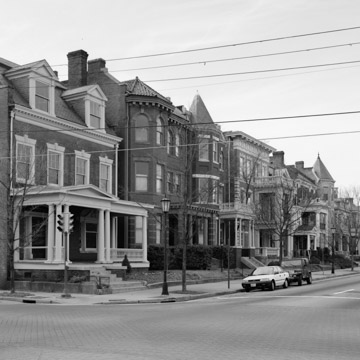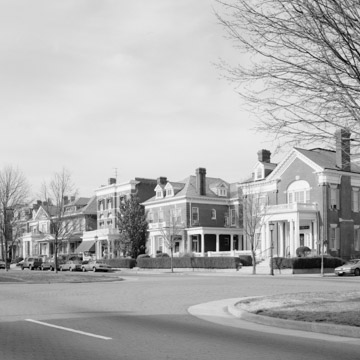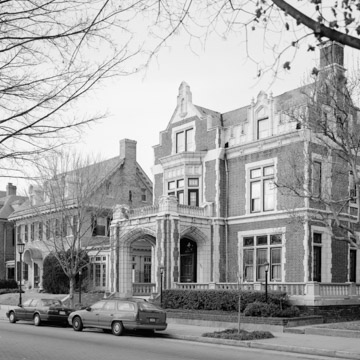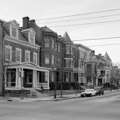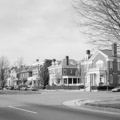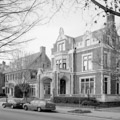To many people these blocks represent the heart of Monument Avenue, for along this segment are some of the street's quintessential Colonial Revival and Georgian Revival houses. The Bullock House (1927, W. Duncan Lee; 2017–2019 Monument Avenue) was designed for use as a doctor's office and residence. The doctor's residential quarters above are elegantly indicated by a central Palladian window. Next door is the Johnson House (1908, Claude K. Howell; 2023 Monument Avenue), a large residence with unusual detailing, in the Tudor Revival mode though carried out in an American Stick Style aesthetic. The Chesterman House (1905–1906, Noland and Baskervill; 2020 Monument Avenue) was the first three-story house on the Avenue and is one of only a few with a limestone facade. A contractor named John Wilson built for himself a huge single-family dwelling, now known as the Wilson House (1911; 2037 Monument Avenue), whose broad, Beaux-Arts facade looks institutional. Many realtors and leaders in building trades saw residences on Monument Avenue as a good advertisement for their firms and their own success and competed in building their own houses. A good example of this practice appears in the next block at the Harry S. Binswanger House (1909, Claude K. Howell; 2220 Monument Avenue), designed for a local window manufacturer. The elaborate facade boasts different window types on each level. A few years later, the vice president of the same window company commissioned the Moses Binswanger House (1913, D. Wiley Anderson; 2230 Monument Avenue).
Across the street, the Rixey Court Apartments (1926, Bascom J. Rowlett; 2235 Monument Avenue) is one of the most glamorous apartment buildings on the street, obviously intended for an elegant white clientele. Its lively facade includes Mediterranean Revival and Beaux-Arts classical elements.
The lots in the 2300 block are wider than those in the previous blocks, providing a spatial amplitude that complements the distinctive freestanding houses and mansions. And yet this block escapes the suburban feeling of some of the blocks farther west.
The Stuart McGuire House (1924, Baskervill and Lambert; 2304 Monument Avenue) is based on Mompesson House in Salisbury, England. A later resident of the house recalled that when the architect asked Dr. Stuart McGuire, who had commissioned it, what type of house he would like, the doctor answered, “I never considered what kind of operation my patients would like; build me a house.” The huge Tudor Revival mansion, the Wallerstein House (1915, Carneal and Johnston; 2312 Monument Avenue), was designed by a firm known for many Collegiate Gothic school and university buildings. Two houses with similar compositions but very different details sit next to each other: the Pollard House (1915, W. Duncan Lee; 2314 Monument Avenue) and the Cary House (1927, William Lawrence Bottomley; 2320 Monument Avenue). The later house is a Colonial Revival version of the Arts and Crafts house next door. A young family owned the earlier house, and the wife's mother admired the floor plan so much that she commissioned Bottomley to design a similar, though smaller, house on the adjacent lot. The red brick and slate give the facade of 2320 a more formal appearance.
An enormous Mediterranean villa on the south side of the street, the Jacquelin Taylor House (1914, W. Duncan Lee; 2325 Monument Avenue) is still owned by the family that built it. At the corner in front of the Davis Monument’s site is the Lewis H. Blair House (1913, Walter D. Blair; 2327 Monument Avenue). It is the only Colonial Revival house on Monument Avenue with a freestanding monumental portico, that stereotypical southern architectural element once dismissed as mere nostalgia, but whose continued use in the twentieth century must also be understood as an oppressive reminder of life on slave plantations.














